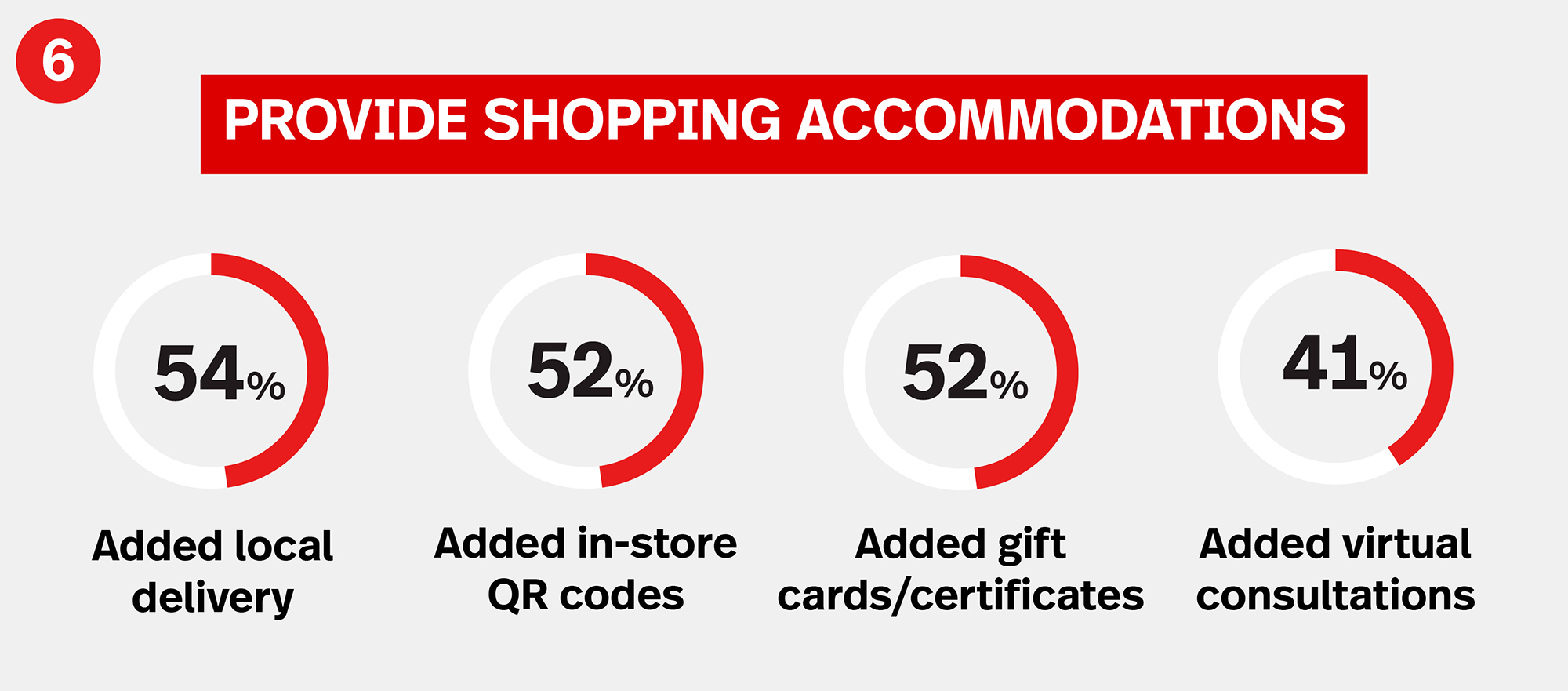
The 2021 holiday selling season is predicted to be a big one for small retail businesses across the country. As we enter a post-COVID-19 era with the release of FDA-approved vaccines, consumers are eager to remedy their pent-up pandemic frustrations with a little retail therapy.
But this act of “revenge spending” won’t be done without careful consideration from consumers, primarily due to ongoing economic uncertainties and shoppers searching for the best deals on online ecommerce platforms and in newly re-opened brick-and-mortar stores.
This means that small business owners must have a plan in place to meet the demands of all types of shoppers this year—including providing both online and in-person holiday selling options. This is especially true as consumers are being urged to get their holiday shopping done early, much like during the 2020 holiday shopping season.
With so much working against small retail business owners in 2021, it might seem impossible to get a holiday selling plan in place prior to the holiday rush. But sometimes the best way to prepare for the future is to look towards our not-so-dissimilar past.
To give you a better idea of how your business should approach the upcoming holiday selling season to maximize sales, Lightspeed surveyed over 700 small retail business owners—including our own retail business customers—that sold their products during the 2020 holiday shopping season.
Below, we will break down these unique insights, as well as nine ways we believe your small retail business can best prepare for the holiday selling season this year and boost sales.
Table of Contents
- What We Learned from the 2020 Holiday Sales Season
- General Merchandise Business Statistics
- Apparel and Footwear Business Statistics
- 2020 Holiday Sales Growth by Generation
- Lightspeed Customers and the 2020 Holiday Sales Season
- 2020 Holiday Digital Marketing Strategy Initiatives
- Useful Lightspeed Features and Functionality
- 9 Ways to Prepare for the 2021 Holiday Sales Season
- 1. Diversify Your Promotional Tactics
- 2. Benefit from Small Business Saturday
- 3. Have an Established Online Presence
- 4. Provide COVID-19 Sanitization Information Early
- 5. Prepare Your Inventory
- 6. Provide Shopping Accommodations
- 7. Accept Several Payment Options
- 8. Leverage Mobile Devices
- 9. Analyze End-of-Season Sales to Prepare for 2022
- Streamline Your 2021 Holiday Selling Season with Lightspeed
2021 holiday sales estimates
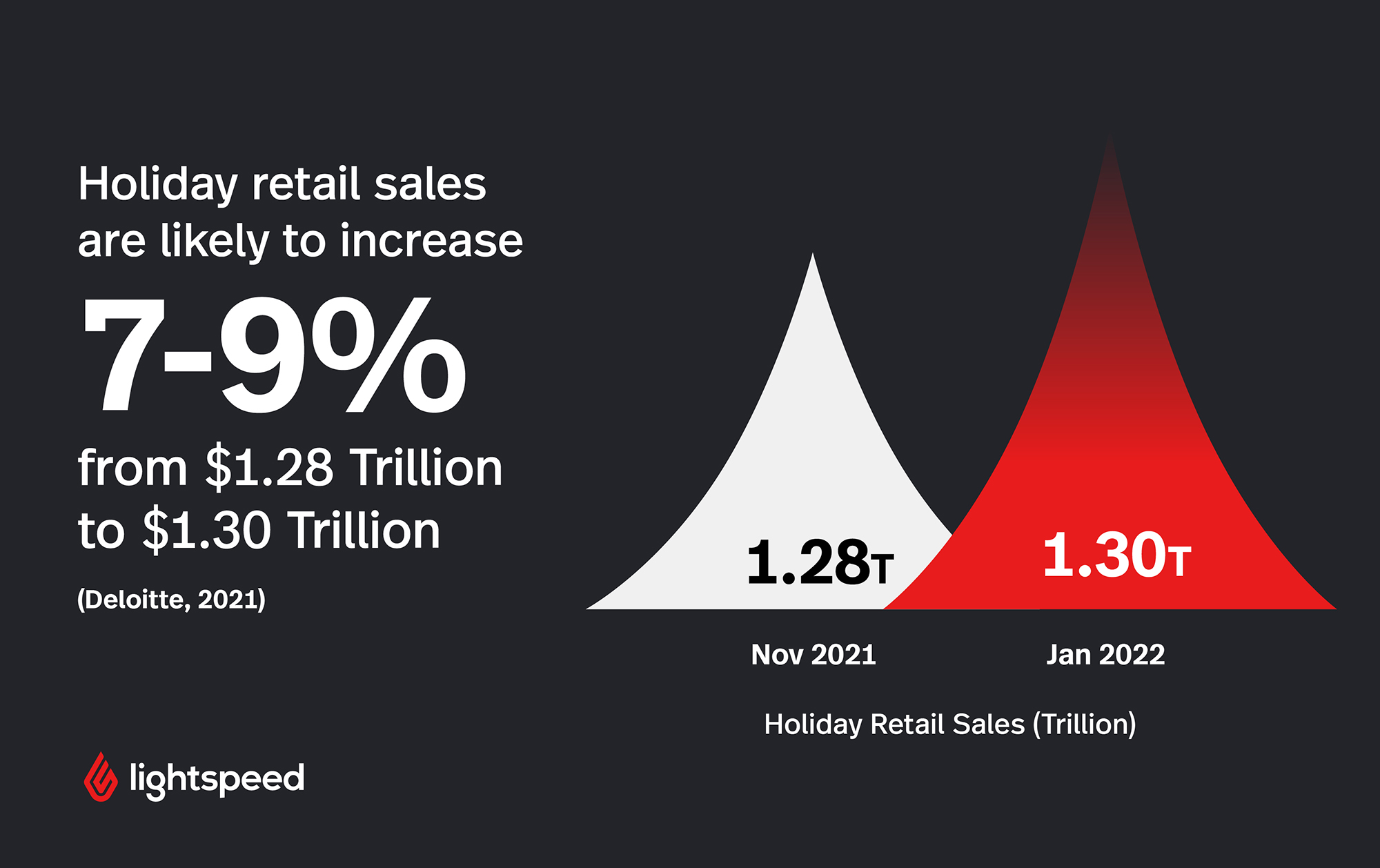
According to Deloitte’s 2021 annual holiday retail forecast, holiday retail sales are likely to increase between 7% and 9%—reaching a staggering $1.28 to $1.3 trillion from November 2021 to January 2022. Curious about how many people shop online during the holidays? In 2020, Adobe Insights Digital recorded online sales during the holiday season to have reached $188.2 billion, which accounted for two years’ worth of growth and more than 1 trillion visits to U.S.-based retail websites. With the push towards digital transformation during the pandemic, it’s no surprise that online holiday sales in 2021 are also projected to trend upward—growing by 11% to 15% year-over-year and reaching between $210 and $218 billion during the same time.
What we learned from the 2020 holiday selling season
As several brick-and-mortar businesses were forced to adapt to pandemic regulations, many turned to holiday selling ecommerce strategies to keep business operations running and reach both new and existing customers. This was especially true during temporary lockdown orders, or when businesses had to deal with reduced store hours or fewer staff members. For many businesses, however, this newfound focus on ramping up ecommerce efforts alongside their brick-and-mortar stores paid off.
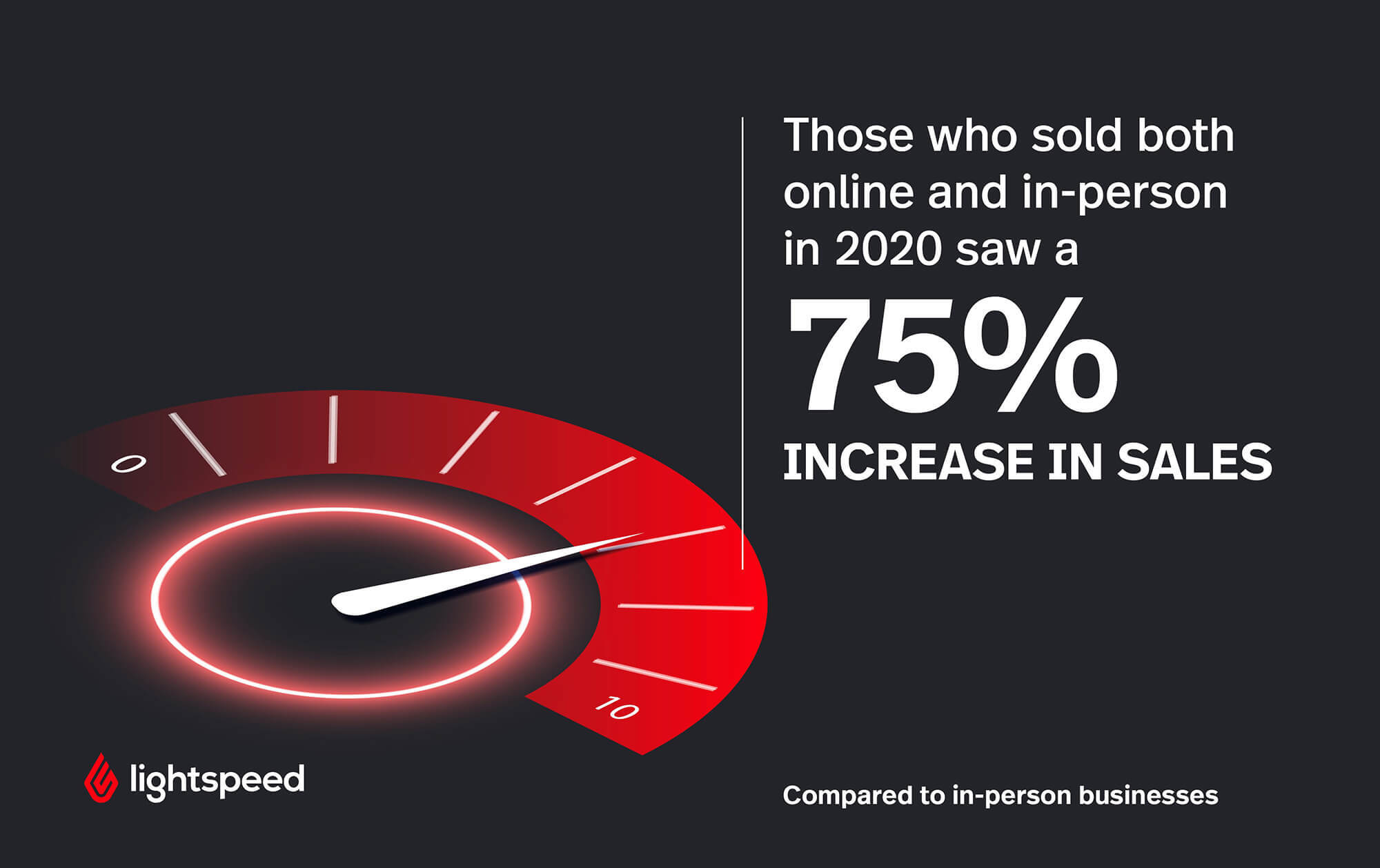
According to the small retail businesses we surveyed, those who sold both online and in-person in 2020 saw a 75% increase in sales compared to those who only sold in person (who only saw at most a 50% increase in sales, if their brick-and-mortar store saw sales growth at all).
Let’s break out the businesses we surveyed even further, taking a closer look at both general merchandise businesses and apparel and footwear businesses, as well as holiday sales growth by generation.
General merchandise business statistics
75% of general merchandise stores we surveyed saw most of their holiday sales come from ecommerce, but most of them sold their products both in-store and online. In addition, 84% of these businesses saw an increase in sales in 2020 compared to 2019—and those who did saw a 50% increase in sales, on average. General merchandise stores’ biggest selling day was Black Friday.
Apparel and footwear business statistics
95% of the apparel and footwear businesses we surveyed increased their holiday sales in 2020 compared to 2019—and of that percentage, sales increased by an average of 25%. 91% of these businesses also saw more sales come from their ecommerce stores than in-stores.
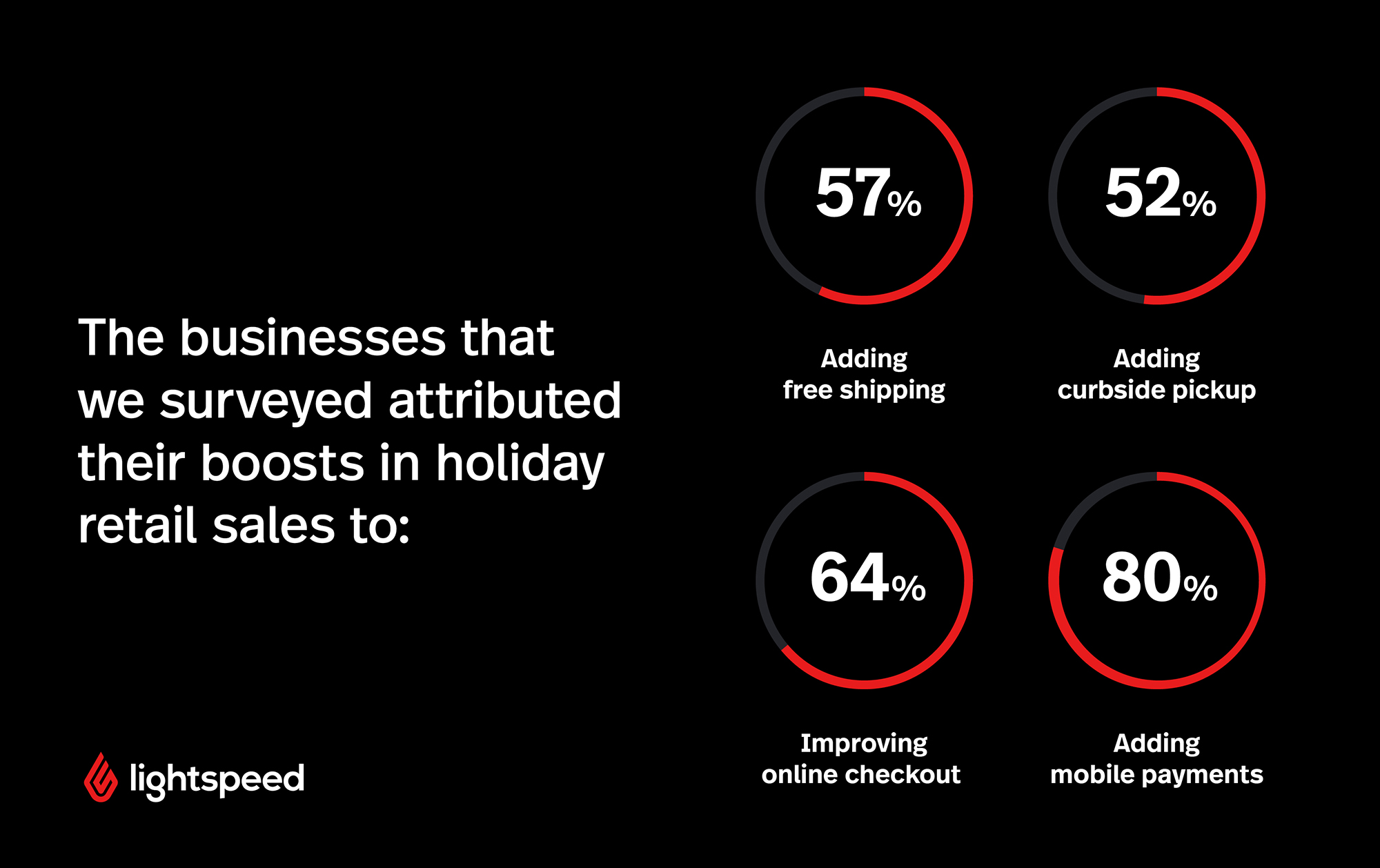
To help boost these ecommerce transactions, 57% of businesses added free shipping and 52% added curbside pickup as an accommodation. Additionally, 64% improved their checkout process on their website, and 80% added mobile payments (e.g., Apple Pay, etc.) as payment options.
Tip: Searching for an apparel point of sale (POS) system that can help you stock, organize, and sell your products faster this holiday season? With Lightspeed’s omnichannel fashion retail POS solution, you can sell both online and in-person with ease this year.
2020 holiday sales growth by generation
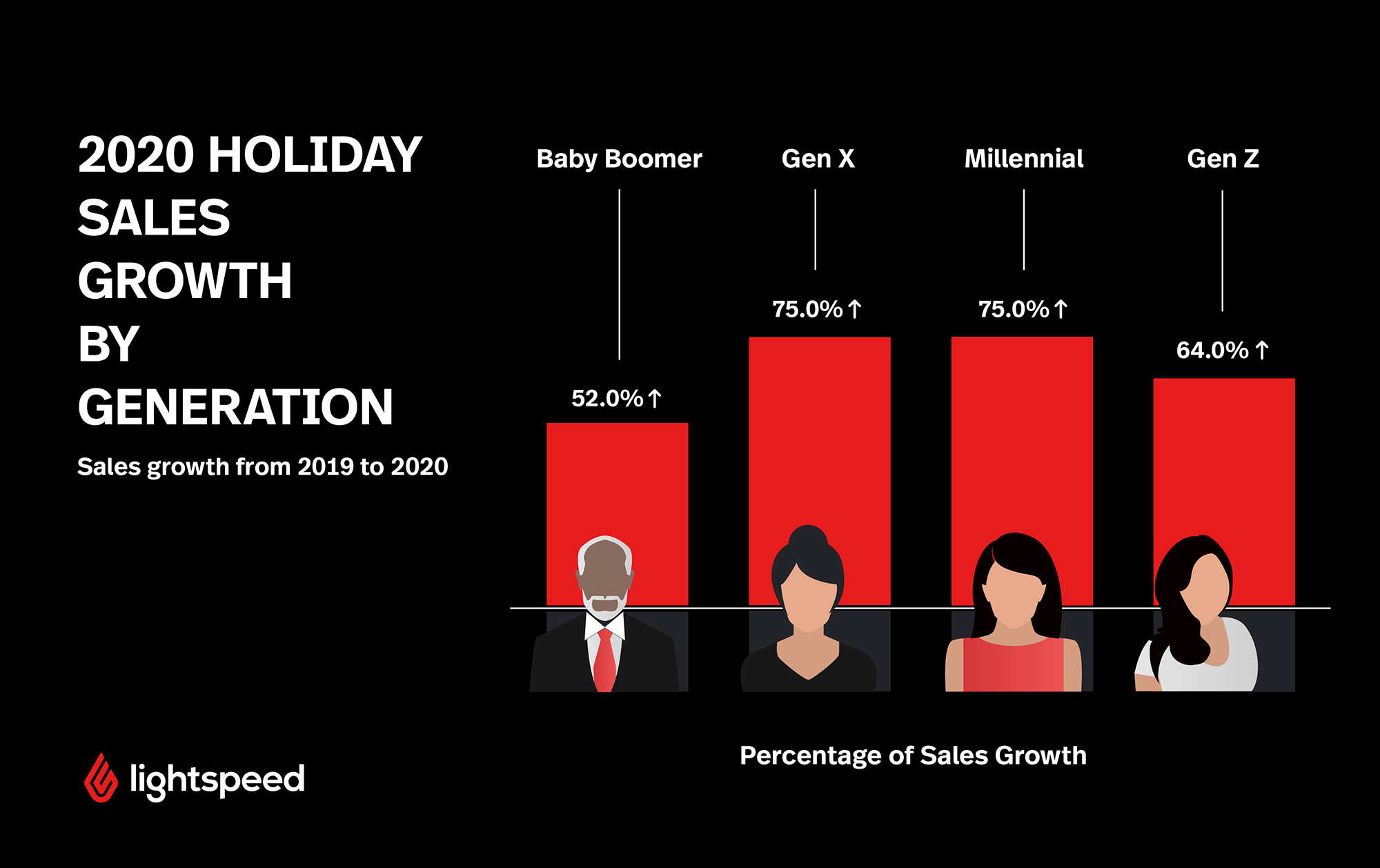
In our survey, we also looked at growth in 2020 holiday sales based on small retail business owners in different generations:
- 52% of Baby Boomer owners saw an increase in holiday sales of at least 50% compared to 2019.
- 75% of Gen X owners saw an increase in holiday season sales of at least 50% compared to 2019.
- 75% of Millennial owners saw an increase in holiday season sales of at least 50% compared to 2019.
- 64% of Gen Z owners saw an increase in holiday season sales of at least 50% compared to 2019.
Of all the groups surveyed, Gen X business owners (58%) were the most likely to focus on consumers’ mobile devices to capitalize on ecommerce transactions. This includes integrating their products with barcode scanning apps for price comparisons, offering mobile coupons, and providing in-store pickup for online purchases.
Lightspeed customers and the 2020 holiday sales season
Lightspeed customers also provided us with unique insights when it comes to the 2020 holiday selling season, including their 2020 holiday digital marketing strategy initiatives, Lightspeed features and functionality they found most useful.
2020 holiday digital marketing strategy initiatives
When it comes to digital marketing and holiday selling ecommerce strategies, 43% of Lightspeed customers used social media posts as an ecommerce holiday marketing strategy, while only 28% used email marketing. This could be because social media platforms gave business owners the chance to quickly reach new audiences across the globe, while email marketing campaigns were restricted to addresses previously collected in email lists. What’s more, holiday-related social media posts typically have higher engagement rates than emails, as customers are more likely to share a social post with their followers than an email.
Paid ads were another common holiday digital marketing strategy for Lightspeed customers, and for good reason. Running paid ads on platforms like Facebook enabled business owners to target niche groups of consumers who were more likely to show interest in holiday promotions. Much like organic social media posts, paid ads work to reach new audiences, promote content sharing, and enhance brand recognition. Other common marketing tactics these customers used included WhatsApp promotions, community events, and ads in local magazines.
Useful Lightspeed features and functionality
Regarding Lightspeed features and functionality, our customers found these most useful for their business during the 2020 holiday sales season:
- 34% of Lightspeed customers found the Inventory Management feature most useful, which enabled them to streamline stock management and access integrated stock ordering tools
- 28% found that Analytics was most useful. This suite of tools enabled customers to review their stock and analyze things like customer experiences and staff performance.
- 14% found that Omnichannel Loyalty was most useful, which enabled them to reward their customers through their ecommerce store just like they would in-store from one unified platform.
14% found Order Management was most useful. This tool enabled customers to closely track orders to ensure customers received them in time and analyze where their stock was going.
9 ways to prepare for the 2021 holiday sales season

Check out The 9 ways to prepare for the 2021 holiday sales season.
Equipped with the 2020 holiday selling season data above, it’s time to prepare for the 2021 holiday season ahead using the nine tips below. But before you get started, try to break down the entire season into specific holidays or events to help you concentrate your selling and digital marketing strategies this year.
For example, Thanksgiving/Black Friday was the biggest revenue-earning holiday for most small retail businesses in 2020 (nearly 50% of the businesses we surveyed selected Thanksgiving/Black Friday as their largest money-making holiday, while only 23% selected Christmas/Hanukkah), so be sure to plan for these dates first and foremost. In addition, Cyber Monday and Super Saturday shopping are also important to prepare for early on.
Tip: Check out this holiday readiness guide to discover 10 ways you can prepare for Black Friday and Cyber Monday this year.
1. Diversify your promotional tactics

With an emphasis on both online and in-person shopping this year, small retail businesses must implement diverse promotional activities to increase sales, as well as to engage with and incentivize customers shopping online and in-person. Based on the results of our survey, small retail businesses that saw an increase in sales during the 2020 holiday season used exclusive deals such as loyalty programs to entice repeat customers (60%), provided a gift with purchase (53%), or offered exclusive giveaways or sweepstakes (48%).
When comparing with Lightspeed customers’ promotional tactics, we found that:
- 48% of customers used percent discounts.
- 41% used loyalty programs.
- 36% used coupon codes.
- 29% of customers used no promotional tactics.
2. Benefit from Small Business Saturday
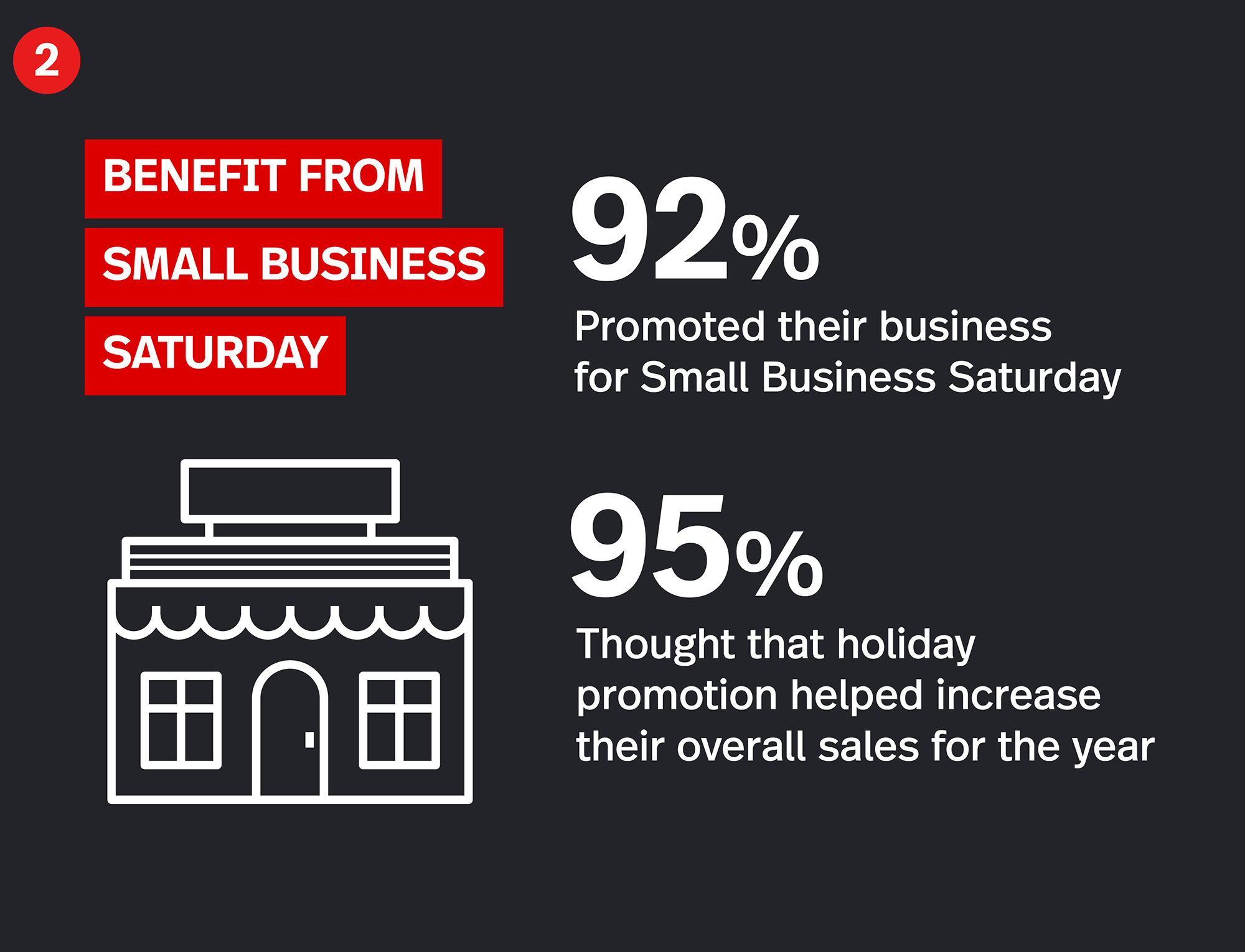
Situated between Black Friday and Cyber Monday, Small Business Saturday is one of the most lucrative holidays for small business owners during the holiday season. According to the U.S. Small Business Administration, U.S. consumers spent nearly $20 billion on Small Business Saturday in 2020—and from 2010 to 2019, consumers spent a total of $100 billion during this holiday. This means there is an enormous opportunity to promote your business in advance—be it through social media posts, email marketing campaigns, or paid ads on search engines like Google—to engage with potential customers and increase sales during Small Business Saturday in 2021.
When looking at our survey, businesses that saw an increase in sales of 75% or more during the 2020 holiday selling season contributed a portion of this growth to promoting their business for this shopping holiday. 92% of business owners promoted their business for Small Business Saturday, and 95% thought that promoting for this holiday helped increase their overall sales for the year.
3. Have an established online presence
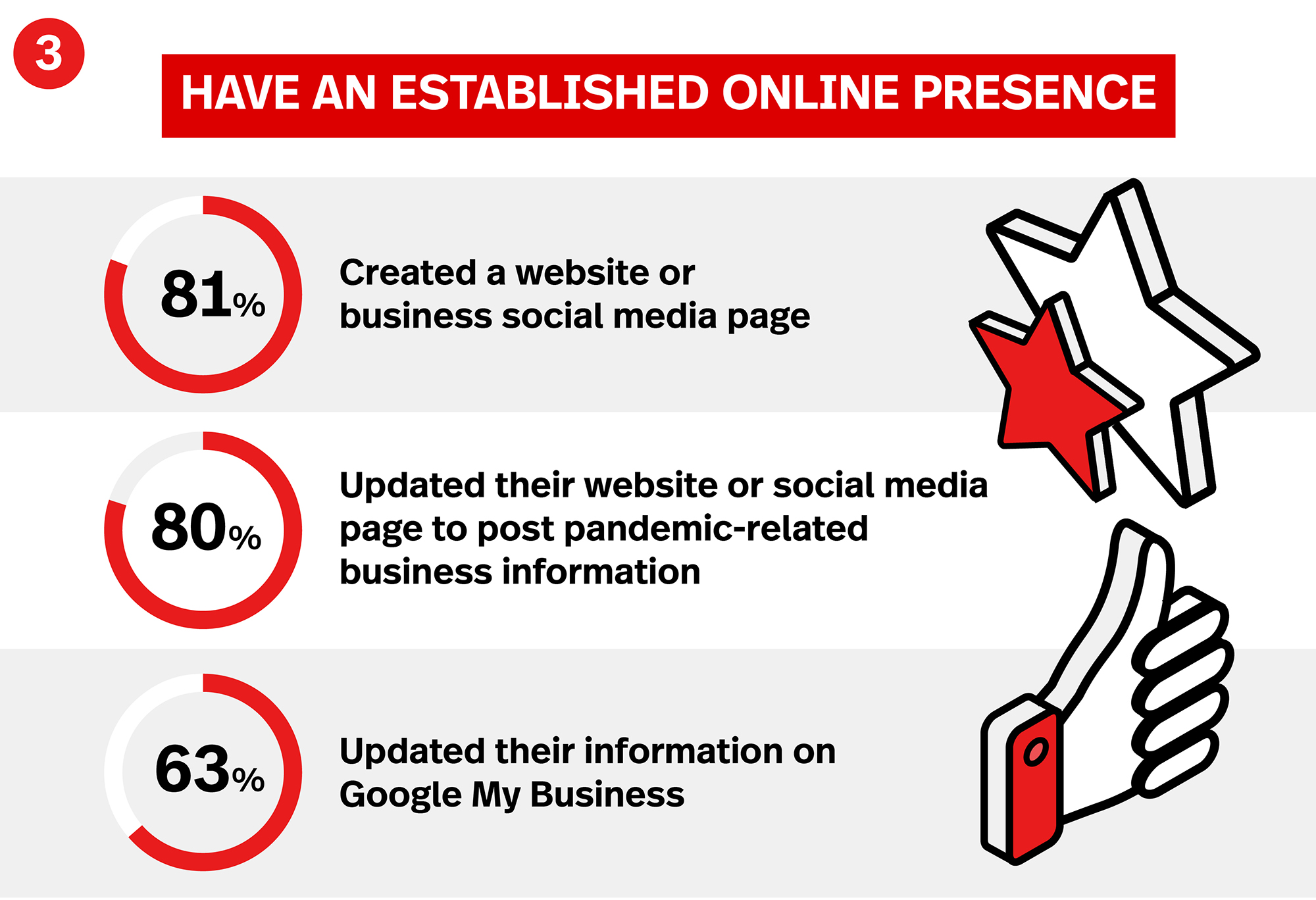
Establishing and maintaining your presence online is key to your holiday selling ecommerce strategy. For each holiday throughout the 2021 season, be sure to use your social media accounts to their full potential to promote your brand. Whether you’re posting to TikTok or running ads on Facebook, social media makes it easy for potential customers to find your business online and know what holiday deals you have to offer.
It’s also important to increase your search engine optimization (SEO) efforts and content marketing on your website prior to each holiday during the season. To do this, try regularly publishing content (e.g., gift-guide blogs related to products you carry) that’s relevant to your brand and captures your customers’ attention.
Another important holiday selling ecommerce tip is to identify keywords your customers are searching for and optimize your site with them. This makes it easier for your site to appear in the search engine results page (SERP) for your chosen keywords and easier for customers to find you when they are tackling their shopping lists.
According to our survey, small retail businesses were able to increase ecommerce sales by 75% or more during the 2020 holiday selling season by maintaining a presence online.
- 81% created a website or social media page for their business.
- 80% updated their website or social media page to post pandemic-related information about their business.
- 63% updated their Google My Business information to ensure their information was up to date.
Unfortunately, 40% of the small retail businesses we surveyed who didn’t maintain an online presence during the 2020 holiday selling season didn’t see an increase in sales.
4. Provide COVID-19 sanitization information ahead of time

Sanitization efforts and social distancing continue to play a big role in the success of brick-and-mortar retail businesses—and letting customers know about these efforts in advance helps to ensure they feel safe and understand what precautions are expected of them before they visit your store. Be sure to update your social media accounts, business website, and Google My Business account with updated COVID-19 precautions. If you run a brick-and-mortar store, ensure this information is displayed clearly outside your store, on your front door, or in your store’s entryway.
Of the small retail businesses we surveyed that saw at least a 25% growth in sales during the 2020 holiday season, 94% provided upfront information on sanitization precautions implemented in their businesses. Here’s how these businesses reached their customers with this info:
- 81% posted on social media.
- 76% added posters outside their stores.
- 71% added information on their website.
- 57% added information to their email newsletter.
5. Prepare your inventory
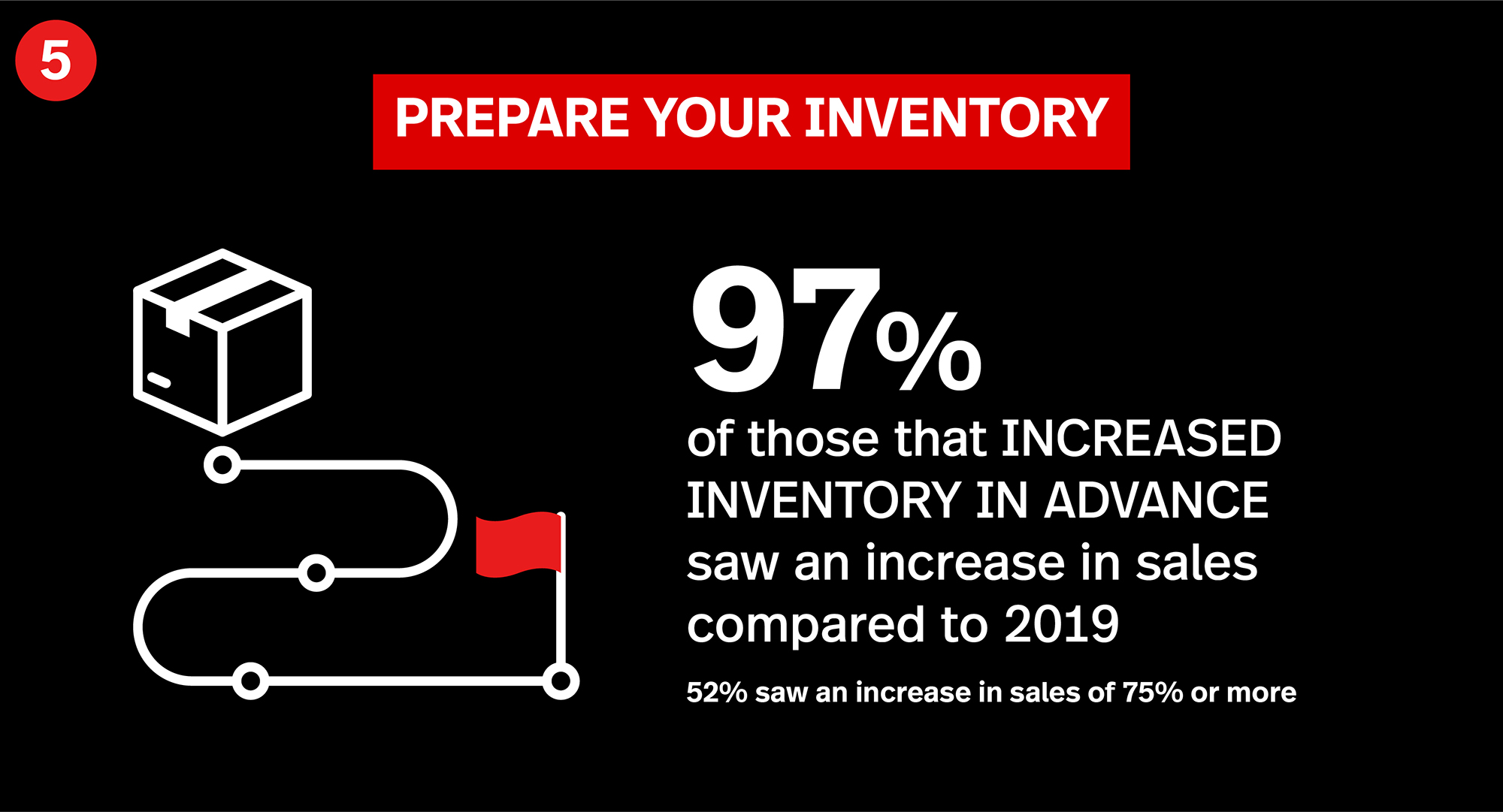
Preparing your holiday-related inventory in advance is critical this year, especially with current supply chain delays. To get started, be sure to calculate a holiday budget by referencing your sales numbers from 2020. Pay close attention to how much you sold on major shopping holidays like Thanksgiving/Black Friday and Small Business Saturday and use these figures to help you estimate how much inventory you will need.
Tip: Rather than using complex, data-heavy spreadsheets to calculate your holiday budget this year, Lightspeed gives you the option to ditch your spreadsheets for a one-stop retail commerce platform—saving you time and resources when preparing your inventory orders.
Once your holiday budget is set, ensure your ecommerce store and/or brick-and-mortar store are stocked up with your most popular items related to each specific holiday or items based on current trends. If possible, think about stocking merchandise that could be sold year-round if you don’t sell through it all by the end of the 2020 holiday season. Not only could this help to reduce your budget, but it could ensure you aren’t stuck with holiday inventory that won’t sell until the next holiday season.
Also, try to connect with your suppliers or vendors about any discounts or extended payment terms they offer when buying products in larger quantities. If you run out of time to stock up on all merchandise or run into major supply chain delays, try to focus only on stocking top-selling products or currently trending products.
According to our survey, 97% of small retail businesses who were able to increase their inventory in advance saw an increase in sales compared to 2019—and 52% of those businesses saw an increase in sales of 75% or more. While 58% of these businesses increased their overall inventory, 40% chose to only increase inventory on selected items.
6. Provide shopping accommodations
As the U.S. deals with the ongoing pandemic, small retail businesses must continue to adapt to changing environments and city-wide regulations quickly and efficiently.
Those that adapted and pivoted their business model during the 2020 holiday selling season saw a 75% increase in sales on average, while those who didn’t only saw a 25% increase in sales (with only 50% of those businesses seeing an increase at all).
To do this, the businesses we surveyed provided unique online and in-store accommodations, such as giving customers the ability to order online and pick up their items curbside, providing outdoor shopping areas, and free shipping deals.
They also shifted store hours to accommodate more customers and upgraded their technology—such as payment processing software and equipment—to ensure they were equipped to handle traffic spikes. Some other key findings about the small retail businesses we surveyed and their holiday shopping accommodations include:
- 54% added local delivery options.
- 52% added QR codes of items in-store for online purchases.
- 52% incorporated gift cards/certificates.
- 41% added virtual shopping consultations.
7. Accept several payment options
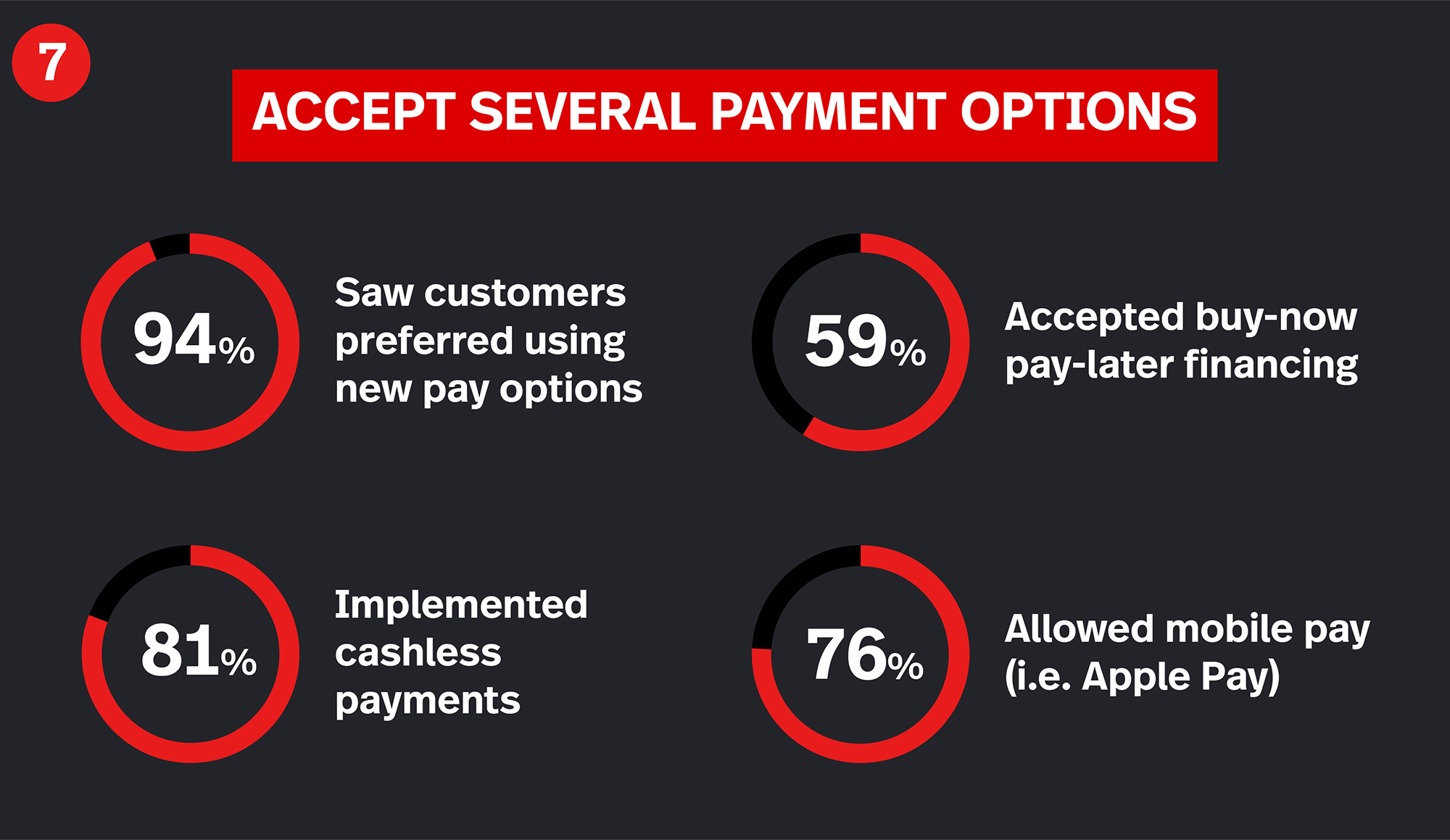
From cash and debit cards to contactless payments and PayPal, be sure that your business allows customers to pay whichever way they prefer both online and in-store during the 2021 holiday shopping season. This also includes buy now pay later (BNPL) options, which are becoming some of the most important holiday selling ecommerce strategies for small retail businesses.
Of the small retail businesses we surveyed that saw an increase of 75% or more in sales:
- 94% saw that customers used their new payment options more than the previous ones.
- 81% implemented a cashless payment rule.
- 59% accepted BNPL financing options.
- 76% of businesses surveyed allowed mobile phone payments, such as Apple Pay.
8. Leverage mobile devices
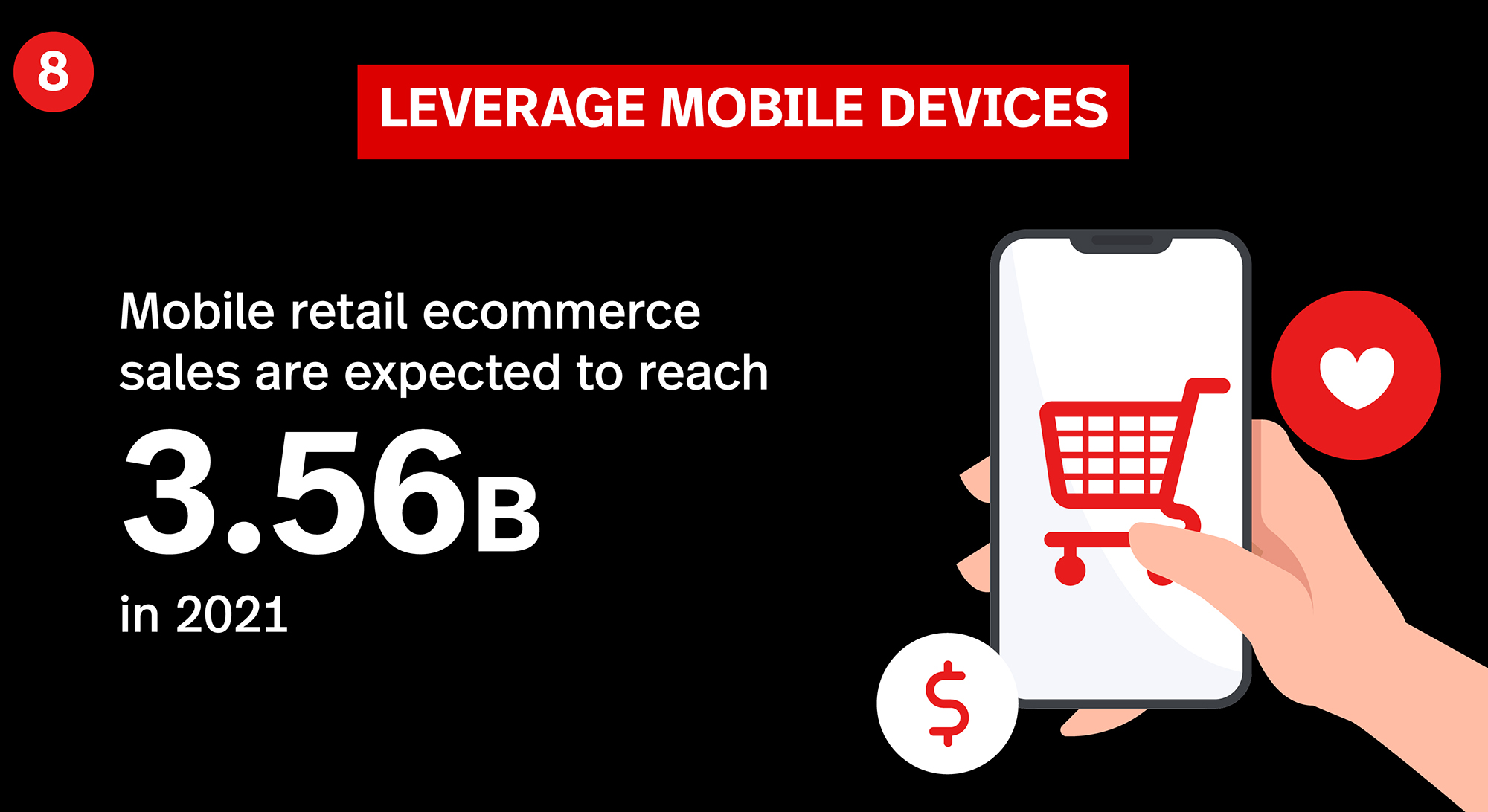
Creating a seamless shopping experience for your customers is more important than ever, no matter if they are shopping online or at a brick-and-mortar store. But there is one tool that consumers are using more than ever to shop for the holidays: mobile devices.
Mobile retail ecommerce sales are expected to reach $3.56 billion in 2021 according to Statista, which means mobile commerce is slated to dominate holiday shopping as consumers reach for their smartphones instead of their desktops or laptops.
This means that two of the most important holiday selling ecommerce strategies are having a fast, mobile-responsive website and spending some of your advertising dollars on mobile-oriented social media platforms (e.g., Instagram, Snapchat, and TikTok). In addition, offering mobile-first shopping incentives such as coupons or price comparison capabilities can boost your digital marketing strategy even further.
When reflecting on our survey, 49% of small retail businesses leveraged customer’s mobile phones during the 2020 holiday selling season by incorporating mobile price comparison functionality via barcode scanning applications. Additionally, 24% of businesses provided customers with the option to make online purchases and pickup in-store, and 18% offered mobile-first coupons.
9. Analyze end-of-season results to prepare for 2022
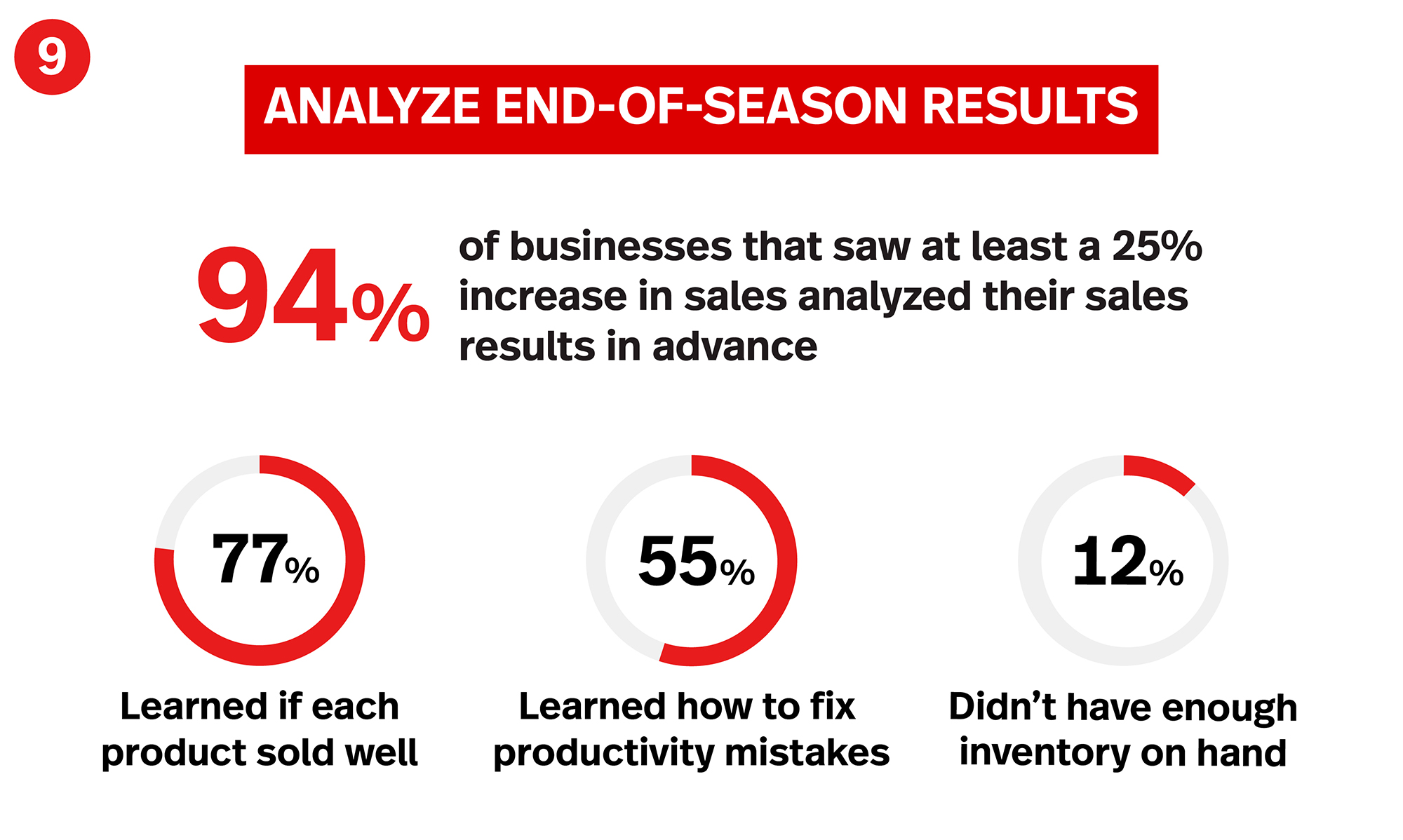
It’s never too early to get started on your holiday selling plan for next year. This means it’s important to analyze your end-of-season sales results and retail reports as soon as possible to get ahead of any inventory requirements, productivity issues, or staff management discrepancies.
Based on results from our 2020 survey, 94% of small retail businesses that saw at least a 25% increase in sales from the 2019 holiday season analyzed their sales results in advance. In doing so, 77% learned which products sold well and which didn’t, 55% learned how to fix productivity mistakes, and 12% learned that they didn’t have enough inventory on hand to meet consumer demand. When it came to staff management, business owners found that 60% of estimated employee hours were as planned, while 50% found that employee hours were over-budgeted.
For Lightspeed customers, 82% found out which products sold well and which didn’t, 24% found out that the hours planned for employees were correct (while 10% found that hours were exceeded), and 28% learned from productivity mistakes.
Streamline your 2021 holiday selling season with Lightspeed
The 2021 holiday selling season is anticipated to be one of the largest for small retail businesses, so ensuring you’re prepared for both online and in-person shoppers is more important than ever.
Interested in learning more about this year’s top holiday selling ecommerce strategies, customer demands, and how your small retail business can stay prepared? Be sure to download our Holiday Trends Report 2021: What SMB Retailers Need to Know today to get the inside scoop.
If you’re ready to exceed your targeted sales goals this holiday season, Lightspeed is here to help. Featuring advanced software that can help you secure and grow your business, our one-stop retail POS system is built to help you simplify sales and inventory, create streamlined retail store manager reports, scale operations, and provide exceptional customer experiences.

News you care about. Tips you can use.
Everything your business needs to grow, delivered straight to your inbox.
